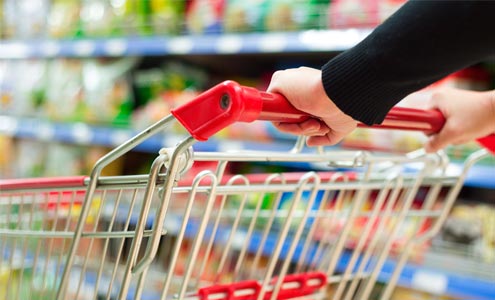2 Hidden Dangers in Everyday Products You Must Know About

You walk down an aisle in the huge supermarket that stocks just about everything imaginable. Your cart already contains food, about which you feel virtuous because you conscientiously read labels to avoid unhealthy additives.
Spying a shampoo brand you saw in a TV ad, you drop the plastic bottle into your cart. The same brand of hair conditioner gets snapped up next. Further along, toothpastes are displayed. A familiar brand that tastes like peppermint goes into the cart. Since you're in the personal products section, you add deodorant, antibacterial hand soap, hand sanitizer, mouthwash, shaving gel, and—from the cleaning supplies section—dish washing detergent. A package of plastic containers will let you nuke your lunches at work. Next…trash bags in the large economy size—what a great buy, so in they go!
What's this? Some of the cosmetics and skin care products are on sale. Great! Here's a moisturizer at a dollar off and skin cleanser with a fifty-cent discount, not to mention makeup base on special for $2 less than usual, and lipstick in a gorgeous shade at a $3 savings. You saved enough money to buy a bottle of sunscreen for skin protection.
Next is the OTC medication section, where you purchase the store brand of topical ointment for that bit of rash on your arm. What's left? Oh, yes…snag your favorite beverage and you're ready for the checkout line.
What a great shopping trip!
Or, was it?
You've gotten pretty good about reading food labels, which helps you stay away from a lot of nasty additives that can cause everything from weight gain to insulin resistance to heart disease. But there was no label-reading in the non-food sections, was there? Did you think all those products are pure because some of them have the words “natural" and “gentle" on the packaging? That's where you may have made a huge mistake.
The personal product section of any store is a hotbed of toxic ingredients. You thought you were buying toothpaste, mouthwash, deodorant, and other things you've bought countless times before, but what you were really buying was…triclosan. This is a chemical found in numerous consumer products like the ones you bought today, as well as toys, kitchen utensils, bedding and the insoles of shoes, to name a few.
The Centers for Disease Control and Prevention (CDC) reports that triclosan shows up in the urine of seventy-five percent of the U.S population. Their research studies show that triclosan is absorbed through the skin, even at low levels, where it goes into the bloodstream to wreak havoc. Even these low levels can cause thyroid dysfunction. When triclosan gets into the blood of a pregnant woman, it can cause developmental problems in the fetus. Triclosan also interferes with immune system function and opens the door to allergies.
Even more disquieting, triclosan is implicated in the increase of antibiotic-resistant bacteria, or Superbugs. The chemical is not completely removed by waste water treatment plants, so it's been found in waterways, where it kills some forms of aquatic life.
Triclosan is not the only baddie found in the items tossed so casually into your grocery cart. Parabens are cheap synthetic preservatives found in so many products that you will probably find an ingredient ending in “–parabens" (one of six commonly-used forms) on the label of every non-food item you bought.
Parabens were found in the majority of urine samples in a study by the CDC, so it's obvious the chemical in its various forms is easily absorbed by the body. Parabens are linked to disruption of the body's hormone systems and have been detected in breast cancer tumors, proving they not only are absorbed into the body, but can persist in their original form (non-degraded) and accumulate in tumor tissue in the breasts.
Still think you scooped up a bunch of bargains on your shopping trip today? If you begin reading the labels of non-food items as conscientously as you study those found on food packaging, you may avoid these dangerous chemicals that are as bad as, if not worse, than the additives you routinely shun in processed foods.
Are there alternatives to the many triclosan-and-parabens-laden products stocked on shelves and available from online vendors? Yes, but they aren't available on a grand scale, and they will undoubtedly cost more because they aren't produced using cheap toxic chemicals. Still, it is possible to find safer alternatives in personal products through an Internet search. One excellent source is the Skin Deep cosmetic and skincare database maintained by the Environmental Working Group.
It's also best to stay away from any product—including cutting boards, shower curtains and toys—designated “antibacterial," even if triclosan isn't listed as an ingredient.
Sadly, tricking consumers is now considered a fair marketing practice.
Suggested Resources

What about allowing more industrial waste to be dumped in our environment? That is what is being called cutting costs in this country!
I argue at what cost? Polluted air water and industrial waste quietly being dumped? Do you trust the companies or the government to protect you? Yes take away access to healthcare and simultaneously make it legal to dump waste like chemicals and worse, like heavy metals I.e. lead mercury, arsenic into our environment?
OMG waaaaay too long. If you want more readers, please
get to the point faster. Most people can't read that much without
getting turned off.
Thanks for the information.
Debbie
As far as buying an antibacterial cutting board, the best one you can buy is a good sturdy one made from one of our most renewable resources, wood. A cutting board made from hard maple or walnut, for example, have inherent antibacterial properties as part of its biological makeup. Look at what our ancestors used for centuries. They had wooden cutting boards, bowls, utensils, and so on.
Related Keywords








